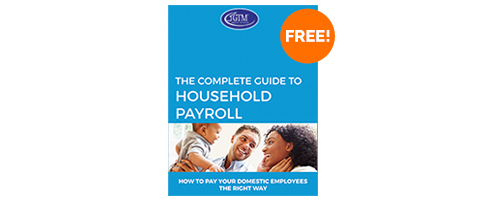
The flu isn’t the only health crisis families and their employees have to address this year as we approach the winter season. Public health experts are fearing a potential “twindemic” between COVID-19 cases and the flu. Here are some preventative actions to help keep your family and nanny healthy and protected as you prepare for flu season during the pandemic.
The arrival of the fall and winter months signals many things, including the beginning of flu season. Each year, the flu has a marked impact on many families. The past few flu seasons have seen high hospitalization and mortality rates, which has public health experts fearing another deadly flu season.
Unfortunately, the 2020-21 flu season isn’t the only health crisis families and their employees have to address this year. According to the Centers for Disease Control and Prevention (CDC), flu activity peaks between December and February. This means that the COVID-19 pandemic isn’t the only public health concern as we approach the winter months. This combination has public health experts fearing a potential “twindemic” in surges of COVID-19 cases and another deadly flu season. The CDC is urging the public to take action to avoid another deadly flu season and prevent the further spread of COVID-19 cases.
As an employer, you can help keep your workers healthy and minimize the impact influenza has on your family. The CDC recommends strategies to help you fight the flu and talk to your employee about what a flu season during the pandemic looks like.
Educating your employee on the flu vs. COVID-19
Unfortunately, because the flu and COVID-19 are both contagious respiratory illnesses, some of the symptoms are similar. For example, common flu symptoms include the sudden onset of fever, headache, fatigue, muscle aches, congestion, cough, and sore throat. Most people recover within a few days to less than two weeks. Occasionally, complications such as pneumonia, bronchitis, or other infections can occur. Seasonal influenza can cause serious complications for people of any age, but children and the elderly are more vulnerable.
The list of COVID-19 symptoms is vast, and the disease affects people differently, with some experiencing little to no symptoms and others experiencing severe illness. Generally, symptoms can appear two to 14 days following exposure to COVID-19.
One of the difficult aspects of the COVID-19 pandemic is that the symptoms are wide-ranging and vary in severity. Some with COVID-19 may experience little to no symptoms, while others may be severely ill and require hospitalization.
According to the CDC, the most common COVID-19 symptoms include:
- Fever or chills
- Cough
- Shortness of breath or difficulty breathing
- Fatigue
- Muscle or body aches
- Headache
- New loss of taste or smell
- Sore throat
- Congestion or runny nose
- Nausea or vomiting
- Diarrhea
Because there is some overlap in symptoms between COVID-19 and the flu, it may be difficult to determine whether you or your employee have the flu or COVID-19 without being tested. So it’s important to encourage your employee to stay home if they are sick. If they test positive for COVID-19 and need to take time off to recover, they are eligible for paid leave under the Families First Coronavirus Act (FFCRA) and possibly through state-mandated paid sick leave laws. Paid time off taken under FFCRA can be reimbursed to you through tax credits.
If you believe you have the flu or COVID-19, call your doctor and explain your symptoms before going to a facility to seek care. That will help ensure you receive the care you need without risking the spread of COVID-19. Encourage your employee to do the same if they have symptoms of the flu or COVID-19. You may consider offering a virtual medicine service so your employee has “round-the-clock” access to a physician. Or consider other health benefit options like a Qualified Small Employer Health Reimbursement Arrangement (QSEHRA).
Preparing your home for flu season during the pandemic
There are a variety of steps you can take to protect your employee and prepare for flu season — which may include steps you’ve taken in response to COVID-19.
Here are some strategies to consider:
One of the most important steps for preventing the flu is to get an annual flu vaccination. It is your best chance of preventing the illness. The CDC recommends that all people over the age of six months get a flu vaccine each year. Educate your employee about the importance of vaccination and encourage them to get the flu vaccine. Provide them with information about local (and sometimes free) opportunities to get vaccinated. Offer to reimburse them for any costs associated with getting vaccinated.
The flu virus and the virus that causes COVID-19 can remain on surfaces long after they’ve been touched so it’s important that your home is frequently cleaned and disinfected. Some best practices include:
- Cleaning and disinfecting all frequently touched surfaces
- Providing disposable wipes so that commonly used surfaces can be wiped down before each use
- Avoiding close contact with people who are sick, and stay away from others when you feel under the weather.
- Implementing and enforcing social distancing protocols (deliberately increasing the physical space between people to avoid spreading illness), which can include:
- Avoiding gatherings of 10 or more people, especially those that aren’t socially distanced and don’t require masks or face coverings
- Instructing your employee to maintain at least six feet of distance from other people
- Discouraging your employee from shaking hands
- Wearing a protective face covering or cloth mask when out in public.
- Ensuring that your employee understands how they can prevent the spread of COVID-19 and the flu:
- Encouraging good respiratory etiquette and hand hygiene
- Washing hands often using soap and warm water to protect against germs
- Providing tissues and no-touch disposal receptacles
- Placing hand sanitizers – approved for use by the Food and Drug Administration – in multiple locations to encourage hand hygiene
- Reminding your employee to not touch their eyes, nose, or mouth
- Encouraging employees to err on the side of caution if they’re not feeling well, and stay home when they’re sick or are exhibiting common symptoms of COVID-19 or the flu
- Getting plenty of sleep, staying physically active, and drinking plenty of water to keep immune systems strong
- Managing stress and eating a nutritious diet rich in healthy grains, fruits, vegetables, and fiber
Prevention strategies featuring education on flu prevention, vaccination promotion, and good hygiene will help protect your family and employee. By taking action now and doing your part, you can help prevent the spread of COVID-19 and another deadly flu season.
Requiring your employee to get a flu shot
In general, you may have a policy that urges or requires your employees to be vaccinated for the flu. The CDC says that getting a flu vaccine this year is “more important than ever during 2020-2021 to protect yourself and the people around you from flu, and to help reduce the strain on healthcare systems responding to the COVID-19 pandemic.”
The Equal Employment Opportunity Commission, however, has long taken the position that employers should encourage, but not require employees to get the flu vaccine.
Whether you should mandate the flu vaccine may depend on the nature of the work being performed. For example, it may be more pertinent if you employ a senior caregiver to work closely with an elderly loved one who may be more susceptible to the flu. Or you have a nanny caring for an infant who is too young to get vaccinated.
Be prepared if your employee requests an exemption from a mandatory flu shot due to a medical condition or religious accommodation. Instead of a flu shot, you could ask your employee to always wear a mask while on the job to help stop the spread of germs.
Requiring a flu shot should be discussed during the hiring process and included in your nanny contract or work agreement so everyone is clear on expectations.
Hiring a nanny?
Download Your Guide to Hiring a Nanny. In this guide, we lay out the steps on how to hire a nanny the right way and maintain a strong relationship with your employee.





